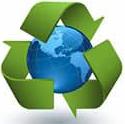Recycling...an help to sustainability - Polyestertime
Main menu:
Recycling...an help to sustainability
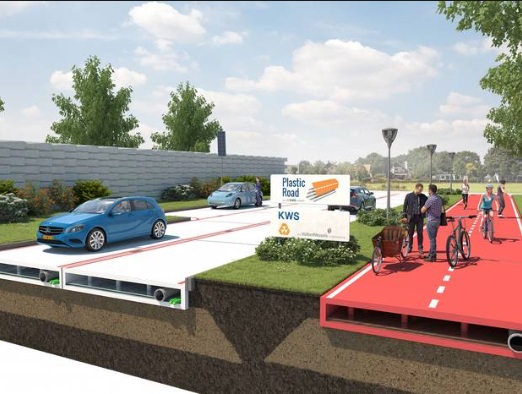
Regulation is denying European companies access to plastic recycling export markrts,BIR conference told
6 Nov 2014 | Author: Paul Sanderson

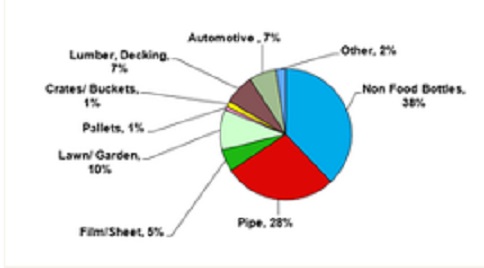
US PET recycling rate improves, but work is needed

Recycling group releases shrink sleeve label guidelines
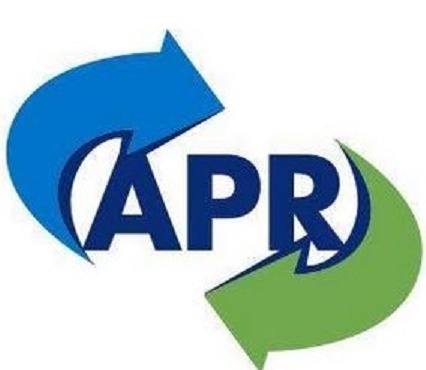
PET to PET boosts recycling capacity

Coke's new shrink sleeve designed for easier
recycling
By Jim Johnson, Plastics News
12 December 2013
Soft drinks giant Coca-Cola is testing a new full-sleeve plastic label on one of its products for the
Christmas holiday season which it believes will make for easier recycling.
Shrink sleeves – full-bottle labels that provide plenty of room for graphics and product information – are
growing in popularity.
But they also are proving to be a difficult material for plastic recyclers to handle because they throw off
sorting equipment, high-tech and low-tech alike.
Full-sleeve labels can cause problems for optical sorters, for float tanks and for air separation technology,
and for a variety of reasons.
But Coke has developed a new label made from a polyolefin mix instead of a modified PET that mixes
with the clear bottle flake in float tanks. Instead, the new label material rises in a float tank and separates
from PET that settles to the bottom.
“We’re quite proud and feel like it’s a good step forward for the industry.
“We’re not saying it’s a silver bullet resolution by any means. But we really want to do our part and feel
like this is a good step,” said Jeff Meyers, the drinks company’s manager of sustainable packaging.
“There’s a bunch of real world testing that’s been done to advance and actually commercialise a new label
from Coca-Cola,” he said. “The story here is we believe we are the first to market with an Association of
Postconsumer Plastic Recyclers-compatible (APR) label per their guidelines.”
The APR, a trade group that has been working to address shrink sleeve label impacts on recycling, has
established a set of shrink sleeve guidelines to help manufacturers make their products more recyclable.
The issue has been growing as these labels gain traction in the market, said APR technical director John
Standish. Bottles with full-sleeve labels currently accounts for about 5% of recycled plastic bale and is
expected to continue to grow in the years ahead.
This year, Standish said, was “a pivotal year because these labels got big enough in the market stream
that it started to financially hurt the reclaimers. And what seems to be the direction people are going is to
put in this machinery that mechanically rips the label off because nothing else has been available.”
Full-sleeve labels can fool optical sorting equipment into believing they are seeing coloured resin. They also
can mix with and contaminate clear PET grind at the bottom of separation tanks. And they can become
mixed in with PET from lightweight water bottles because of their similar characteristics when recyclers use
an elutriation process that uses air for sortation.
Coca-Cola tested thousands of bottles in real-world conditions by attaching the new mixed polyolefin labels
and pushing product through the supply chain “to make sure this new material would stand the test of time
in real-world conditions”, Meyers said. “But we didn’t just stop with our operations, we also took the bottles
and sent them to a few different PET recycling plants and let them work on it.”
With encouraging results, Coca-Cola decided to use the new shrink sleeve on its single-serve orb-shaped
bottle available during the Christmas holiday season at retailer Wal-Mart. Every one of those bottles has the
new label.
Green Matter: New technology for greener PLA
Wednesday, January 16, 2013
By Karen Laird
An intriguing European project aimed at developing a new polymerization route for PLA will kick off this month at the
Fraunhofer Institute in Pfinztal (Germany).
Among the many bioplastics available today, one of the best known is polylactic acid, or PLA. And it's certainly one of the
fastest growing: in August of last year, Germany-based nova-Institute published the preliminary results of a multi-client
market survey of the international bioplastics market, which projected a production capacity of over 800,000 tons of PLA
by the year 2020, up from around 180,000 tons in 2012. As Michael Carus, managing director of nova-Institute, noted: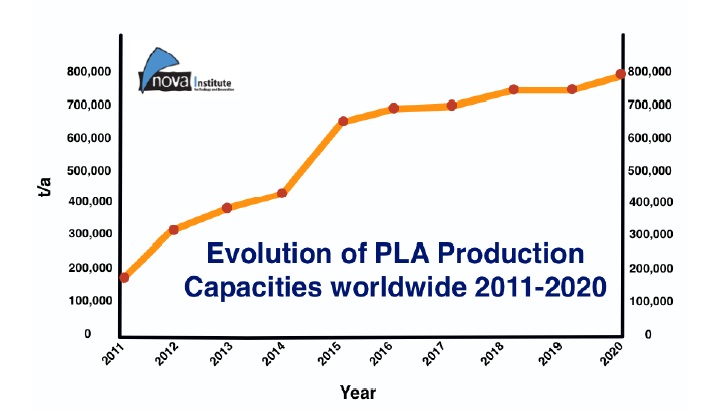
"PLA is definitely a polymer for the future."
What is PLA, exactly?
It's actually a biodegradable, aliphatic polyester that is derived from lactic acid. Lactic acid is easily obtained from
inexpensive, renewable agricultural feedstocks, such as beets or corn. The naturally occurring sugars in the feedstock, or
those that are produced by breaking down carbohydrates in the feedstock are fermented to lactic acid, from which lactide
and the PLA resin are produced.
PLA is a high-strength and high-modulus thermoplastic that is easily processed using conventional processing
techniques. Moreover, it is safe for use with food. As a result, PLA has fast become widely used in numerous
applications; common uses are as loose-fill packaging, compost bags, food packaging, disposable tableware, non-woven
textiles and films, to name but a few.
So why the new project?
Currently, most PLA on the market today is produced using a continuous process applying ring-opening polymerization
to convert lactide to PLA. The process involves the use of tin catalysts, thus "completely eliminating the use of costly and
environmentally unfriendly solvents" as one of the main PLA producers active in the market today points out. However,
because of health and environmental concerns related to the use of tin, the InnoREX project is aimed at developing an
alternative polymerization route for PLA that is nonetheless able to yield the same level of performance. This will involve
a novel reaction concept involving the continuous, highly precise, metal-free polymerization via reactive extrusion.
Organic catalysts will replace the metal-containing catalysts currently in use. While these have been shown to efficiently
control the lactide polymerization process, their activity must still be improved to meet industrial standards. The activity of
these catalysts can be increased through the application of low-intensity, meticulously targeted alternative energy
(ultrasound, microwave or laser light energy), using commercial co-rotating twin screw extruders as reaction vessels. The
rapid response time of microwaves, ultrasound and laser light enables a precisely controlled and efficient, continuous
polymerization of high molecular weight PLA, as both the reaction and the resulting molecular structure of the polymer
can be dynamically controlled. Product quality is assured due to an in-line cleaning device that will purify the polymer to
remove traces of any remaining catalyst and monomer residues.
Moreover, combining polymerization, compounding and shaping in a single production step will achieve significant
energy savings.
Eleven partners including small and medium enterprises, research centers and trade associations from around Europe
are participating in the InnoREX project. The project will run for 42 months, ending on May 31, 2016
Premiere Fibers signs agreement with biotechnology firm
December 22, 2012 (United States Of America)

Premiere Fibers, a global industry leader in the development and production of specialized performance fine denier yarns for branded apparel and technical fabric applications, announced it has entered into a strategic relationship with Verdezyne, a privately held industrial biotechnology company focused on producing renewable bio-based chemicals.
Verdezyne will supply its bio-based adipic acid to Premiere Fibers for use in their industry-leading sustainable Nylon 6,6 yarns.
"Throughout the marketplace there is a steadfast commitment to superior performance and sustainability in all branded products we proudly support," said John Amirtharaj , president of Premiere Fibers.
"The performance advantage we offer in fine denier low DPF filament yarns using Nylon 6,6 is clear. However, this same superior chemistry presents unique challenges in sustainability. We believe the solution is multidimensional, combining our leading recycling processes with renewable bio-based resources. This also supports our objective of reducing dependency on petroleum-based raw materials. Micro-organisms may very well become the chemical producers of the future, and we enthusiastically welcome this opportunity to work toward common objectives with Verdezyne on our quest to achieve sustainability."
"From the source of its ingredients, to the scale of its environmental footprint and multiple useful lives, this brings us significantly closer to achieving our goal of providing the world with fiber technology that is truly sustainable and not reliant on oil," said Brendan McSheehy , Universal Fiber Systems' director of Innovation and Sustainable Technology.
“Holding this bio-based Nylon 6,6 yarn in my hands, and knowing that more than half of its content came not from petroleum, but from fermented waste plant stock, I am both humbled and proud. Humbled that we are taking a big step toward achieving a petroleum-free polymer, and proud that we are collaborating with true innovators like Verdezyne."
"As leaders in sustainable fiber technology, we are extremely pleased to be partnered with Premiere Fibers in commercializing Verdezyne's bio-based adipic acid for use in their "EcoInnovation Fiber," said E. William Radany , Ph.D., president and CEO of Verdezyne.
"Premiere Fibers has set themselves apart by creating high-performance, innovative and sustainable Nylon 6,6 filament yarns, and we are thrilled to be collaborating with such an outstanding company."
SPLASH researches on deriving polyester from sugar
December 20, 2012 (Germany)
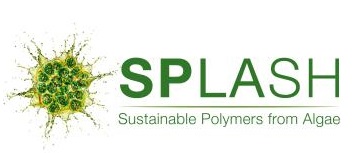
On 19-21 November 2012 the twenty partners involved in an EU funded research programme held their kick-off meeting in Wageningen, The Netherlands. Led by Wageningen UR Food & Biobased Research, the 4-year project has the goal to develop a new biobased industrial platform using microalgae as raw material for the sustainable production and recovery of hydrocarbons and (exo)polysaccharides from algae and their further conversion to renewable polymers.
Sustainable Polymers from Algae Sugars and Hydrocarbons (SPLASH) will deliver knowledge, tools and technologies needed for the establishment of a new industry sector: Industrial Biotechnology based on algae and/or algal genes for the manufacture of polyesters and polyolefins.
The project covers the whole process chain from optimized biomass production to product development and exploitation. In a first step, two industrial bioproduction platforms will be explored: the green alga Botryococcus braunii and the green microalga Chlamydomonas reinhardtii, to which the unique hydrocarbon and polysaccharides producing genes from Botryococcus will be transferred. Biomass cultivation is targeted to reach a pilot scale.
Following steps will develop procedures for the production, in situ extraction and isolation of sugars and hydrocarbons, which will be further processed into polymers: Polyesters from sugars and polyolefins from hydrocarbons.
Furthermore, the project will explore the possibilities for the production of high-value end-use applications, such as fibres for yarns, ropes and nets. This exploitation will also include market analysis and environmental assessments.
Project partners
The project comprises twenty partners, of which 55% are SMEs and large enterprises and the remaining 45 % are universities and research institutes. The research consortium is being managed by Wageningen UR Food & Biobased Research.
Institutes and universities include the Centre for Research and Technology Hellas (CERTH), The Chancellor, Masters and Scholars of the University of Cambridge, Fraunhofer-Gesellschaft zur Förderung der angewandten Forschung e.V., Universidad de Huelva, EGE Universitesi, Westfälische Wilhelms-Universität Münster, Wageningen Universiteit and Universität Bielefeld, while companies such as nova-Institut für politische and ökologische Innovation GmbH, PNO Consultants BV, Lankhorst Euronete Portugal SA, Rhodia Operations, Organic Waste Systems NV, Paques BV, Biotopic, Value for Technology BVBA (VFT), Avantium Chemicals BV, Lifeglimmer GmbH and Pursuit Dynamics PLC form the other part of the project consortium.
SPLASH
October 2012
Strong bioplastic growth led by bio-PET
by Doris de Guzman
Another delayed post is this press release last week from the industry trade group, European Bioplastics, on their annual report on the global bioplastic capacity/production status and five-year growth projections.
The report, which is published in cooperation with the Institute for Bioplastics and Biocomposites from the University of Hannover (Germany), noted a fivefold growth of the global bioplastics production capacity — from 1.2m tonnes in 2011 to 5.8m tonnes projected for 2016.
The strongest growth will be led by bio-based, non-biodegradable bioplastics group such as bio-PE (polyethylene) and bio-PET (polyethylene terephthalate), which are dubbed “drop-in” solutions. Remember our bioplastic cheat sheet here?
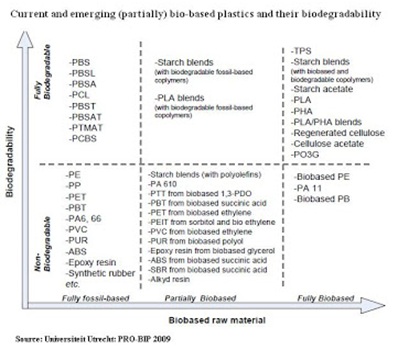
According to the European Bioplastic report, biobased PET is already accounting for 40% of the global bioplastics production capacity. Partially biobased PET will continue to grow to more than 4.6m tonnes by 2016, which will accoount for 80% of the total bioplastics production capacity in that time frame.
Following PET is biobased PE with 250,000 tonnes, accounting for more than 4% of total production capacity.

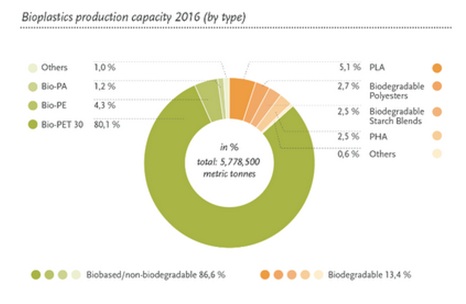
Biodegradable plastics such as PLA (polylactic acid) and PHA (polyhydroxyalkanoate) are also contributing to the growth, says Hasso von Pogrell, managing director of European Bioplastics. PLA global capacity is projected to grow to 298,000 tonnes (up by 60% from 2011), and PHA capacity to 142,000 tonnes (up by 700% from 2011 baseline).
Production trend in terms of location, however, seems to be shifting to Asia and South America. Europe and North America are reportedly still hotspots for research and development as well as salema 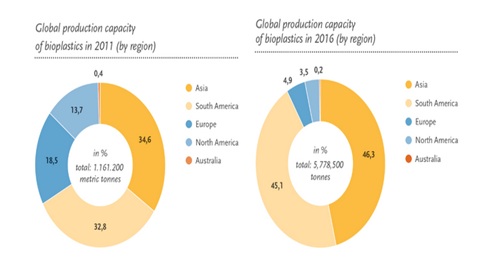
Because of this shifting production trend, European Bioplastics is calling European policy makers to do something about it and make biobased product markets as key priority in their industrial policy highlights.
In other recent bioplastic market reports, Transparency Market Research also released its new study stating that the global synthetic and bio-based biodegradable plastics market was worth $2.3bn in 2011 and is expected to reach $7.8bn in 2018, growing at an aggregate growth rate of 19.5% within the period.
Europe is said to continue leading the market in terms of revenue, and will account for 37% of the global market revenue share in 2018. Asia Pacific, meanwhile is expected to grow at 26% from 2011 to 2018 in terms of market share.
I guess this next study will dampen bioplastic’s good news as according to Germany’s Federal Environment Agency (UBA), the overall ecological benefits of renewable-based biodegradable plastics used in packaging is no better than traditional petroleum-based plastics.
The study, according to UBA, was commissioned to determine whether the special provisions for biodegradable plastic packaging introduced by the German Packaging Ordinance –which are due to expire at the end of this year — are still defensible from an ecological viewpoint.
“The bottom line is that packaging made of so-called bioplastics are not better for the environment. The climate impact of bioplastics may score better, but they are negative in a number of other environmental areas,” said Jochen Flasbarth, President of the Federal Environment Agency (UBA).
“The study results make a case for ending the special regulations for this type of packaging, which include exemption of retailers from the take-back obligation.”
The use of fertilizers is the culprit as according to the study, the farming and processing of the plants used in packaging cause more severe acidification of soil and eutrophication of water bodies than the production of common plastic packaging. This also leads to higher level of particulate emissions.
“Reusable bags made of fabrics and other durable materials are in fact the real ecological alternative.” – UBA
This should be an interesting topic to follow up at the upcoming 7th European Bioplastics Conference on November 6 and 7 to be held in Berlin. I wish I could attend!
March 2011
Plant-Based Bottles
HOT TOPIC 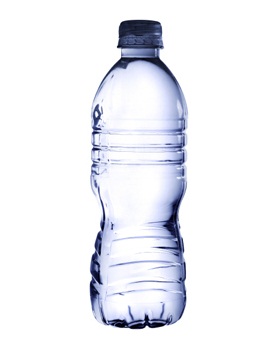
Two beverage industry giants are changing the way we drink our beverages - and the way we consume a variety of other products. The Coca-Cola Company and PepsiCo have each developed their own plant-based bottle technology that aims to significantly reduce the carbon footprint created by Polyethylene terepthalate (PET) bottles.
PET is made up of two components - ethylene, which accounts for 30% of the weight of PET, and terephthalate, which accounts for the other 70%. Historically, both of these compounds were created using petroleum.
Essentially, plant-based bottles are made by converting plant material into renewable versions of these compounds.
The Coca-Cola Company calls their product PlantBottle™, which is a PET substance made partially from renewable plant material. Launched in 2009, PlantBottle packaging is made through a process that converts sugarcane ethanol from Brazil into monoethylene glycol (MEG).
Compared to petroleum-based PET, PlantBottle products can reduce carbon emissions by up to 25%. Also, PlantBottle can be processed through existing manufacturing and recycling facilities without contaminating traditional PET.
In other words, it can be used and recycled repeatedly.
PlantBottle looks, feels and functions just like traditional PET, but it does so with a lighter footprint on the planet and its scarce resources.
Because it's made partially from plants, it reduces potential carbon dioxide emissions and dependence on fossil fuels compared with traditional PET plastic.
Coca-Cola's use of PlantBottle packaging in 2010 alone eliminated almost 30,000 metric tons of carbon dioxide - the equivalent impact of approximately 60,000 barrels of oil from our PET plastic bottles.
"At Coca-Cola, our packaging vision is zero waste. We take our role as a leader in sustainable packaging innovation seriously," says Scott Vitters, General Manager, PlantBottle Packaging Platform, The Coca-Cola Company. "Coca-Cola is actively working to prevent waste over the life of our packaging by advancing consumer recycling programs and increasing our use of recycled and renewable material in our packages.
PlantBottle packaging is our latest packaging innovation - the first-ever fully recyclable PET plastic beverage bottle made partially from plants."
In its first year, PlantBottle launched in nine global markets, including Brazil, Canada, Chile, Denmark, Japan, Mexico, Norway, Sweden and the United States, on brands like Bonaqua Water, Barqs, Coca-Cola, DASANI, Fresca, iLOHAS, Sokenbicha, Sprite, and vitaminwater.
They used over 2.5 billion PlantBottle packages to deliver a variety of Coca-Cola brand products in 2010, and have plans to more than double that number in 2011.
Beginning in April, Odwalla is transitioning to its own 100% recyclable, HDPE PlantBottle, which is made of up to 100% plant-based materials derived from molasses and sugarcane juice.
The Coca-Cola Company also recently announced a partnership with Heinz to use the PlantBottle technology on all of Heinz's 20-ounce ketchup bottles by June 2011.
"We are determined to lead the consumer packaged goods (CPG) industry away from its dependence on non-renewable fossil fuels and towards using renewable plant-based ones.
As the world's largest beverage producer, we have the ability to create a real, lasting impact on the packaging industry. We are willing to take the lead and help others make the change.
Heinz is the first company to join us in adopting PlantBottle packaging and we hope others will follow," says Vitters.
For their part, PepsiCo has announced the development of a bottle made entirely from plant-based resources like switch-grass, pine bark and corn husks.
The bottle will look, feel and protect the product inside in exactly the same way that traditional bottles do, except that they will be produced from 100% renewable and recyclable resources derived from biomass or agricultural byproducts, says Denise Lefebvre, Senior Director of Advanced Research at PepsiCo.
"To the consumer, the plant-based bottle will be indistinguishable from a bottle made from fossil-fuel sources," says Lefebvre. "With this development, PepsiCo continues its leadership position in environmental sustainability and driving progress against the global goals and commitments it announced in 2010 to protect the Earth's natural resources through innovation and more efficient use of land, energy, water and packaging."
PepsiCo has not yet determined which markets or PepsiCo brands will be involved in the pilot test for their renewable bottles, but they do anticipate doing so by 2012.
Although they do not have any current plans in place to license the technology to other companies, they are certainly open to considering an open platform in this area, as the product has such positive implications for the environment.
Future innovations are on tap for both companies.
Currently, The Coca-Cola Company's packaging innovation teams are working to develop a plant-based solution for purified terephthalic acid (PTA) - the other 70% of PET by weight.
Over the past four years, they have initiated a multi-technology, multi-partner R&D program focused on developing a scalable and sustainable solution for plant-based PTA. The issue has not been whether it can be done, says Vitters, but rather how to do it sustainably.
"The team is working to advance technologies to extract sugar from plant-based wastes for future generations of PlantBottle packaging.
Each of these initiatives has a profound impact on our packaging supply chain, which we are literally rebuilding to accommodate the sustainable production and use of PlantBottle packaging. Our ultimate goal is a carbon neutral, 100% renewable, responsibly sourced bottle that is fully recyclable," says Vitters.
Other recent environmental advancements by PepsiCo include developing the world's first fully compostable bag for SunChips, and transitioning Naked Juice to a 100% post-consumer recycled plastic bottle called reNEWabottle™.
"We applaud Coca-Cola, and every other company that is making improvements in the area of sustainable packaging. All of the developments that have been made are beneficial to the environment so the more we all do, the more we all benefit," Lefebvre adds.
Vitters agrees, "We welcome others in the industry joining us in advancing the science behind packaging made from plants."
August 2010
David Clark from Amcor discusses sustainability
in SPE Blow Molding Conference

David Clark, Director of sustainability from Amcor Rigid Plastics, will deliver a keynote message in this October's Blow Molding Conference, sponsored by SPE (Society of Plastics Engineers, US)'s Blow Molding Division and staged from October 5 to 6 in Atlanta, Georgia, US.
In his speech, Clark will convince blow molders serving the packaging industry that sustainability can mean much more than light-weighting bottles and can even generate opportunities.
"Dave will provide attendees with an overview of Amcor's sustainability program and how it is integrated into its business strategy and everyday operations," said Scott Steele, chairman of the Blow Molding Division and vice president of Plastic Technologies Inc. "There is general misunderstanding of what sustainability is and why blow molders should care about it. Molders know about light-weighting and recycle use, but they may not be aware of the other opportunities a sustainability mindset can bring to their business."
Clark leads Amcor's EnviroAction program to enhance the environmental profile of Amcor Rigid Plastics' plants and products, combining his hands-on technical and project-management skills with an interest in finding more sustainable business strategies. He is closely involved with PET recycling and issues related to the collection, processing, and use of recycled containers, as well as integrating sustainable design into Amcor's product development and innovation processes.
The Blow Molding Conference will feature industry speakers presenting segments in both packaging and industrial applications. Planned sessions include: PET/Polyolefins Outlook, Industrial Processing Equipment, Sustainability and Light-weighting, New Packaging Materials and Applications, Industrial Materials and Applications, Blow Molding Optimization and Packaging Machinery Advancements.
July 2010
drirelease offers fabrics from recycled
polyester fibers
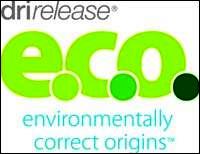
drirelease, known for providing fabrics that offer superior performance to the athletic and fashion apparel markets, is introducing its new drirelease environmentally correct origins (e.c.o.) using Repreve recycled polyester fibers in Europe and the United States.
The new drirelease e.c.o. fabrics combine the superior wicking and fast-drying properties of drirelease while incorporating Unifi's Repreve fibers, which are made of 100% post-consumer recycled polyethylene terephthalate, or PET, the material commonly used to make plastic bottles and other synthetic containers. The new drirelease e.c.o. fabrics will also incorporate FreshGuard odor control, delivering the full line of benefits from drirelease in a fabric that ensures environmental consciousness to customers.
"We've seen a lot of companies make claims about environmentally-friendly fibers and fabrics in the last few years, but were weary of the level of candor behind these claims," said Chris Moore, General Manager of Optimer Labs. "Using Unifi's Repreve fibers, which are certified to ensure recycled content, we can feel confident that our customers can trust drirelease e.c.o. fabrics to deliver the same excellent performance they know and expect from drirelease in a fabric that is verified to be environmentally friendly."
Repreve fibers are made with a unique Fiberprint technology, which allows the testing of post-production garments to verify the Repreve content of the product. ''We wanted to give customers confidence in our recycled content claims, and the Repreve brand provides traceability of the components of our fabrics,'' added Moore.
The new drirelease e.c.o. fabric made its European debut at the Outdoor Show in Friedrichshafen, Germany in July, and is making its U.S. debut at the Outdoor Retailer Summer Market in Salt Lake City, Utah in August.
To see the fabric for yourself, visit the Optimer Brands booth at: Outdoor Retailer Summer Market -- August 3 - 6, Salt Lake City, Utah, U.S.A.; Booth # 62029.
drirelease and FreshGuard are registered trademarks of Optimer Brands.
Repreve is a registered trademark of Unifi, Inc. Fiberprint is a trademark of Unifi, Inc.
May 2010
Custom Polymers PET expanding Alabama
bottle-washing capacity
Custom Polymers PET LLC is tripling its recycled PET bottle-washing capacity at Athens, Ala., with an expansion that it hopes to complete by January.
Company executive John Calhoun II said the new plant will have the capacity to recycle and wash 100 million pounds of PET bottles and produce 70 million pounds of recycled PET flake annually. Calhoun is a partner and co-founder of Custom Polymers Inc. of Charlotte, N.C., the parent company of Custom Polymers PET.
Just 17 months ago, Custom Polymers PET began making recycled food-grade PET pellets in Athens. That plant began operating at maximum capacity in the third quarter of last year and is able to wash 50 million pounds of PET and produce 30 million pounds of recycled food-grade pellets a year for the commercial market.
Calhoun said construction began last month on the new 50,000-square-foot building at its 19-acre site in Athens.
The expansion will bring the total wash capacity in Athens to 150 million pounds, and means Custom Polymers PET will have 70 million pounds of recycled PET flake and 30 million pounds of recycled food-grade PET pellets to sell into the commercial market.
"The demand for recycled PET is increasing - not just for consumer packaging, but for a whole variety of consumer and [original equipment manufacturer] products," said Calhoun. "There is growing demand for recycled content in a much wider array of end products."
The new plant will be the fourth building at the site in Athens, which currently has a 70,000-square-foot warehouse, an 80,000-square-foot facility with two wash and sort lines, and a 50,000-square-foot plant using Vacurema PET extrusion technology from Erema North America Inc. in Ipswich, Mass., to produce the recycled food-grade PET pellets.
Custom Polymers partner Phil Howerton - who co-founded the company with Calhoun in 1996 - said the wash line at the new plant in Athens will use "the newest and latest technology in bottle washing."
With the expansion and the technology at the new plant, Calhoun said Custom Polymers PET "will be positioned to be one of the low-cost producers" of recycled PET - which he calls a necessity. "Eventually, for recycled resin to be sustainable, it has got to be on parity with virgin material," he said.
The other major challenge for recycled PET flake and pellet producers remains supply, he said.
"A lot of capacity is coming on line to process and recycle PET bottles, and there is a shortage of raw material coming into the market," said Calhoun, as 50 percent of baled PET bottles are exported and sold to China.
"If demand continues to come on line, it will be difficult to compete for baled bottles because everyone will be chasing the same supply," he said.
The concern over supply shortages also creates uncertainties for future PET expansions down the road, and whether those expansions will be to produce flake or recycled food-grade pellets.
"We would love to grow the PET business even more," said Calhoun. Custom Polymers PET is one of the few companies selling recycled pellets and flake into the commercial market, rather than producing it for internal use, he added.
Source: Plastics News
April 2010
Bekaert presents 'Second Life' using New Life
yarn April 1 2010 (Belgium)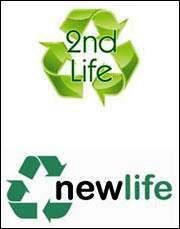
Bekaert Textiles Europe proudly presents "Second Life", a fine collection of mattress tickings, using Miroglio Group'sd top quality New Life yarns that have been recycled from used pet bottles.
Yarn spinners Miroglio and textile producers Bekaert Textiles are looking at ways to reduce the ecological footprint of their industrial activity and to improve their eco efficiency. As there is not enough space on the globe to exclusively live on organic and natural products, we need smart sustainable solutions. Offering novel products to the market, allowing the industry to engage in cradle-to-cradle concepts, is a step in the right direction.
Governments and citizens with a sense of responsibility across the EU are supporting the reduction, collection, recycling and re-use of litter. This is a must if we want to preserve the planet for our grandchildren. Using recycled polyester for yarn production saves energy and reduces water consumption and carbon emission drastically.
"It was crucial for Bekaert European Ticking to engage in this project with the right partner, says Philip Ghekiere,innovation manager of Bekaert Textiles, and our partner Miroglio combines technical expertise, transparent quality assurance with inspiring enthusiasm".
Let us join the big corporations like Nike, Nokia and Sony and re-use millions of bottles, tons of waste for a cleaner world.
Bekaert Textiles NV, founded in 1892 and since 1992 a member of Gamma Holding, one of Europe's largest textile groups, is a multi-national company with production units in 7 countries worldwide and headquarters in Belgium.Bekaert Textiles is the leading specialist in the manufacturing of jacquard woven and knitted fabrics: market leader in the worldwide production and supply of bed cover materials. Bekaert European Ticking, with production sites in Turkey and the Czech Republic, is the biggest business unit in the group.
Filature Miroglio started in 1981 as a production mill which was exclusively intended to satisfy the Miroglio Group internal demand, but soon this activity was widened to the outside market. Specialized in polyester continuous filament and cotton or viscose discontinuous yarn, today Filature Miroglio produces 20 million Kilograms which represents 20% of Miroglio Textile turnover. Miroglio's production facilities are situated in Saluzzo, (Italy), Nova Zagora (Bulgaria) and Boumerdes (Tunisia).
Bekaert Textiles NV
April 2010
Pepsi aims to boost bottle recycling to 50 percent by 2018 By Amanda Smith-Teutsch
WASTE & RECYCLING NEWS 
PepsiCo wants to help increase beverage container recycling rates to 50 percent in the United States by 2018, according to a new report the beverage maker published this week.
In the report, available at www.pepsico.com/goalsandcommitments, the company committed itself to establishing partnerships to increase U.S. beverage container recycling, among other environmental goals.
The commitment was developed in cooperation with Boston-based Walden Asset Management and San Francisco-based As You Sow.
To reach the recycling goal, PepsiCo intends to work with other industry leaders in support of existing programs that increase consumer recycling and develop new programs; partner with its bottlers, communities, suppliers, governmental entities and non-governmental organizations in support of innovative efforts to encourage increased recycling; and continue efforts to support recycling infrastructure while using recycled content in containers.
LA SEDA DE BARCELONA IS DEVELOPING THE FIRST
RECYCLABLE PET FOR THE AUTOMOTIVE SECTOR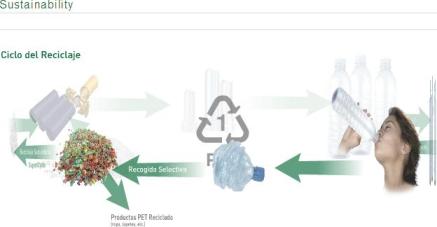
POLYESTER RECYCLING INDUSTRY
PETRA PET RESIN ASSOCIATION